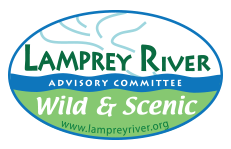Controversies and the Future
A. THREE CASE STUDIES
Overview:
Having considered a variety of historical points of view and uses of the river, students can now address recent controversies involving the Lamprey and its future. One was the attempt to develop the Wiswall dam for electric power and the subsequent decision in 1996 to designate parts of the Lamprey as a national "Wild and Scenic" river. Another is the question of how much access and recreation to encourage on the Lamprey. A third involves maintaining adequate depths and flow for the river’s wildlife. Any of these case studies can be the subject of in-class discussion. While these case studies involve some research, the focus is not on a "report" but on engaging in discussion and debate, with emphasis on conflict resolution techniques. This is contemporary history and the people involved are our neighbors!
Learning Objectives:
Students will
- study primary source materials and interview stakeholders to gather data on current controversial issues regarding the Lamprey;
- see each issue from a variety of points of view, and consider costs and benefits (for people and the river) of each view;
- consider methods for resolving conflicting points of view;
- arrive at a personal resolution of the issues under discussion.
Materials and resources:
- Lamprey River Resource Assessment (available from Lamprey River Advisory Committee)
- Lamprey River Management Plan
- National "Wild and Scenic" legislation http://www.gpo.gov/fdsys/pkg/BILLS-104hr2255ih/pdf/BILLS-104hr2255ih.pdf
- Getting Started in Debate by Lynn Goodnight (see"Resources")
- Environmental Issues Forums, Kendall Hunt Pub. Co., on conflict resolution techniques
- members of the Lamprey River Advisory Committee (see "Resources")
- Rollie Barnaby, extension educator, conflict resolution facilitator UNH, (679-5616)
Procedure:
Students should use primary sources and interview active participants to explore the issues and come to their own conclusions. As students read this material and talk to stakeholders, they should always consider the source of the information and how the interests of the writers or speakers influence their views of the river. On what basis would they judge the validity of the documents? For example, why would the developer applying for a hydropower license indicate on his application that there is no recreational use of the Lamprey?
Using the case study materials and interviews, the class might divide into teams to debate (see Getting Started in Debate) the pros and cons of each issue:
Increased public access to the Lamprey versus a "tread lightly" philosophy.
At the present time, there is limited public access to the Lamprey. The challenge is to diversify and expand use while minimizing impact. How will increased access and more intensive recreational uses, especially motorized, affect wildlife habitat, river bank erosion, scenic impacts, or the quiet desired by passive recreationists? Students might create a continuum of recreational uses, ranging from the highest to the lowest impact.
The Lamprey River In-Stream Flow Pilot Project:
For many years, environmental and dam professionals have been trying to create a plan to manage flows and water levels in the Lamprey. As of 2012, a preliminary plan has been drafted and initial public input has been sought and considered. The issues surrounding this plan are many and complex. The basic concept is to use water from Pawtuckaway Lake and Mendums Pond to supplement the river’s flow during periods of severe drought. The plan focuses on creating a natural flow pattern that would give “pulses” of water to prevent catastrophic losses in wildlife. Students can study the arguments for and against managing the river’s flows from the perspectives of several stakeholders: fishermen, lake-front landowners, river wildlife biologists, lake wildlife biologists, the UNH/Durham Water System, water quality experts, and public drinking water treatment professionals. Basic information can be found here http://www.lampreyriver.org/water-quality-and-quantity-water-quantity-protected-instream-flow and details can be found here http://des.nh.gov/organization/divisions/water/wmb/rivers/instream/lamprey/study.htm.
The McCallen Dam in Newmarket:
The McCallen Dam is a centerpiece of history and character in Newmarket. Built in 1887, it formerly provided hydropower for the Newmarket Mills. As recently as 2011, retrofitting the dam for hydropower has been proposed. Dams require regular and significant maintenance; such maintenance has a high price. Some residents have proposed removing the dam as a means to recreate free-flowing conditions in the river and also as a potential means to manage floodwaters. Landowners along the river in Newmarket are worried that if the dam were removed, their view and recreational use of the river would be negatively impacted, and with that , their property value. Have students review the minutes of the dam removal feasibility public hearing, such as the ones at http://www.newmarketnh.gov/content/view/2349/271/ to get a sense of the arguments. Who has the most compelling argument? How valid are their concerns? (For example, for landowners who fear a loss of scenery, what happened when the Winnicut Dam was removed? What are the costs and expected gains from retrofitting the dam for hydropower?) Which argument seems to be the best for society as a whole?
While the debate format helps students form opinions and use logic and data to support their opinions, a less confrontational format (such as that described by the Environmental Issues Forums listed in "Resources") can help students explore the complexity of an issue and experience the work involved in resolving conflicting points of view. Students learn the facts and arguments as presented by all points of view, weigh the costs and benefits of each proposal, and try to arrive at solutions that meet the needs of the river as well as its human community. Teachers can organize a debate on one case study and a forum on another and invite students to compare the two methods of approaching a controversial public issue. What are the pros and cons of each? How does the winner-loser outcome of a debate compare with the compromise outcome of a forum? What usually happens in political discourse?
B. THE FUTURE AND STEWARDSHIP
Students should end their study of the Lamprey River with a consideration of how we should use the river, now and in the future. The Management Plan 2007 Revision (http://www.lampreyriver.org/about-us-2007-mgmt-plan-revision) suggests some directions for the future such as further study of resources and recreational uses, monitoring water quality, and improving access to upstream water for anadromous fish. What role can each of us play? Students must be reminded that it is not just the river itself, but the whole watershed, that needs safeguarding. The Lamprey River Watershed Guide includes many recommendations for individual actions: care of septic systems, maintaining natural shoreline vegetation, keeping toxins out of the groundwater, and controlling run-off through planned development. Students can consider how they can advocate for the river and what role they might play in the current unresolved questions about the use of the river. As the film concludes, "Everyone of us who lives along the river or visits it helps create the river's future."
Students should write a concluding piece about what they have learned about the Lamprey, how their attitudes toward it might have changed, and how they will think about the river in the future.

